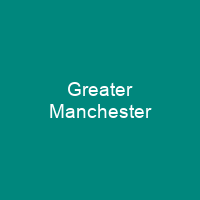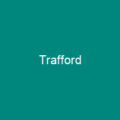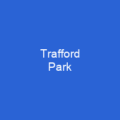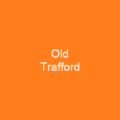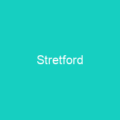Greater Manchester is a metropolitan county and combined authority area in North West England. It comprises ten metropolitan boroughs: Bolton, Bury, Oldham, Rochdale, Stockport, Tameside, Trafford, Wigan, and the cities of Manchester and Salford. Greater Manchester was created on 1 April 1974, as a result of the Local Government Act 1972. It is governed by the Greater Manchester Combined Authority, which consists of political leaders from each of the ten borough councils, plus a directly elected mayor.
About Greater Manchester in brief
 Greater Manchester is a metropolitan county and combined authority area in North West England. It comprises ten metropolitan boroughs: Bolton, Bury, Oldham, Rochdale, Stockport, Tameside, Trafford, Wigan, and the cities of Manchester and Salford. Greater Manchester was created on 1 April 1974, as a result of the Local Government Act 1972, and designated a functional city region in April 2011. It is governed by the Greater Manchester Combined Authority, which consists of political leaders from each of the ten borough councils, plus a directly elected mayor. Andy Burnham is the inaugural Mayor of Greater Manchester, elected in 2017. It has a focused central business district, formed by Manchester city centre and the adjoining parts of SalfORD and Trafford, but Greater Manchester is also a polycentric county with ten metropolitan districts. Since deindustrialisation in the mid-20th century, Greater Manchester has emerged as a major centre for services, media and digital industries, and is renowned for guitar and dance music and its association football teams. It sits within the historic counties of Lancashire, Cheshire, Yorkshire and Derbyshire and borders the ceremonial counties of Cheshire, Derbysshire, West Yorkshire, Lancashhire and Merseyside. There is a mix of high-density urban areas, suburbs, semi-rural and rural locations, but land use is mostly urban—the product of concentric urbanisation and industrialisation which occurred mostly during the 19th century when the region flourished as the global centre of the cotton industry.
Greater Manchester is a metropolitan county and combined authority area in North West England. It comprises ten metropolitan boroughs: Bolton, Bury, Oldham, Rochdale, Stockport, Tameside, Trafford, Wigan, and the cities of Manchester and Salford. Greater Manchester was created on 1 April 1974, as a result of the Local Government Act 1972, and designated a functional city region in April 2011. It is governed by the Greater Manchester Combined Authority, which consists of political leaders from each of the ten borough councils, plus a directly elected mayor. Andy Burnham is the inaugural Mayor of Greater Manchester, elected in 2017. It has a focused central business district, formed by Manchester city centre and the adjoining parts of SalfORD and Trafford, but Greater Manchester is also a polycentric county with ten metropolitan districts. Since deindustrialisation in the mid-20th century, Greater Manchester has emerged as a major centre for services, media and digital industries, and is renowned for guitar and dance music and its association football teams. It sits within the historic counties of Lancashire, Cheshire, Yorkshire and Derbyshire and borders the ceremonial counties of Cheshire, Derbysshire, West Yorkshire, Lancashhire and Merseyside. There is a mix of high-density urban areas, suburbs, semi-rural and rural locations, but land use is mostly urban—the product of concentric urbanisation and industrialisation which occurred mostly during the 19th century when the region flourished as the global centre of the cotton industry.
It roughly covers the territory of the Great Manchester Built-up Area, the second most populous urban area in the UK. Though geographically landlocked, it is connected to the sea by the Manchester Ship Canal which is still open to shipping in Salfords and Trafford. Much of the region was omitted from the Domesday Book of 1086; Redhead states that this was because only a partial survey was taken, rather than sparsity of population. The name SELNEC was used for the area, from the initials of \”South East Lancashires North East Cheshire\”. Before the creation of the metropolitan county, it was known as South East LancASHire NorthEast Cheshire. In the late 18th century the industrialisation of Manchester began an astonishing rate of growth. The industrialisation system enabled the region’s textile trade to expand in the turn of the century as part of the unplanned urbanisation process of unplanned housing, factories and roads. It also encouraged a system of cross-regional trade, like domestic trade, which encouraged a shared tradition of flannel and fustian production, which began in the late 1800s. The region is now the third largest in England after Greater London and the West Midlands. It was once the home of the Celtic Brigantes tribe, and lay on their border with the Cornovii on the southern side of the River Mersey. The remains of 1st-century forts at Castlefield in Manchester, and Castleshaw Roman fort in Saddleworth, are evidence of Roman occupation.
You want to know more about Greater Manchester?
This page is based on the article Greater Manchester published in Wikipedia (as of Nov. 30, 2020) and was automatically summarized using artificial intelligence.
